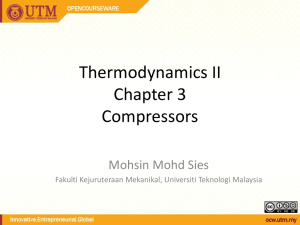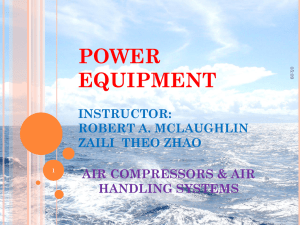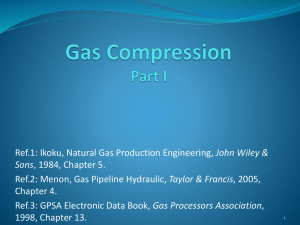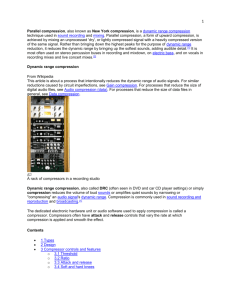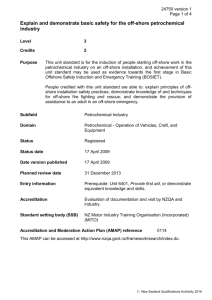even longer project overview - Department of Mechanical Engineering
advertisement
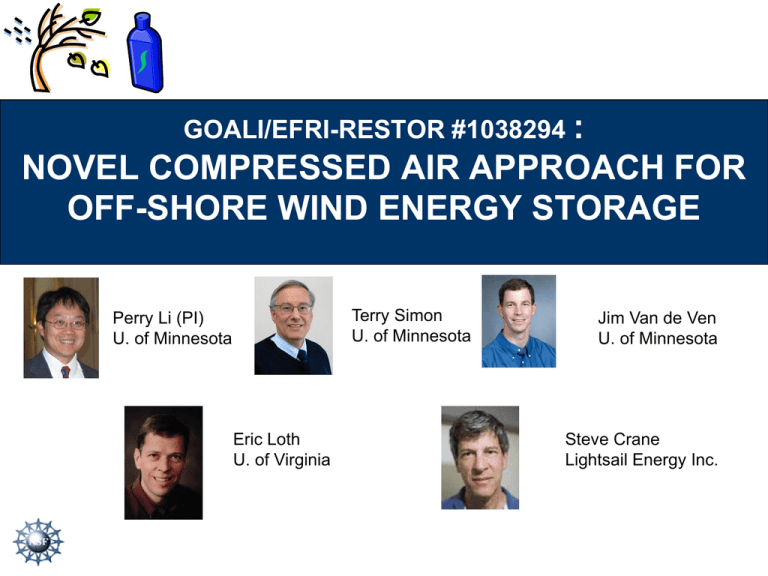
GOALI/EFRI-RESTOR #1038294 :
NOVEL COMPRESSED AIR APPROACH FOR
OFF-SHORE WIND ENERGY STORAGE
Terry Simon
U. of Minnesota
Perry Li (PI)
U. of Minnesota
Eric Loth
U. of Virginia
Jim Van de Ven
U. of Minnesota
Steve Crane
Lightsail Energy Inc.
Near Isothermal Compressed Air Energy Storage Approach For
Off-Shore Wind Energy using an Open Accumulator
Perry Y. Li (PI), Terry Simon, Jim Van de Ven, Eric Loth* and Steve Crane**
University of Minnesota, *University of Virginia, and **LightSail Energy
Challenges:
•Wind energy is intermittent, difficult to predict
•Mismatch between supply and demand
•Potential disruption of base power supply
•Wind turbines are under-utilized: typical
capacity factor < 50%
•High cost of installation, transmission and
interconnect for off-shore wind
Goal: Develop a scalable and rampable system
for storing wind energy locally prior to
electricity generation
Benefits:
•
•
•
•
Predictable output
Store energy when low demand/high supply &
regenerate energy during high demand/low supply
Downside electrical generator, transmission, and
interconnect
Increase capacity factor
Acknowledgement:
NSF-EFRI #1038294
UMN: IREE RS-0027-11;
NSF-CCEFP–2C.1
http://www.me.umn.edu/~lixxx099/EFRI_CAES
http://www.me.umn.edu/~lixxx099/EFRI_CAES
Challenges of wind power:
• Wind energy is intermittent, difficult to predict: disruptive to electrical grid
• Mismatch between supply and demand
• Wind turbines are under-utilized: typical capacity factor < 50%
Power
Rated capacity
Wind power
Unused capacity
Demand
Generated
Generatedpower
power
w/ow/storage
storage
Time
Goal: Develop a scalable and rampable system
for storing wind energy locally prior to
electricity generation
Benefits of local energy storage:
•
•
•
Predictable, reliable output
Increased energy capture
Downsize components, increase capacity factor
Approach
• Store energy in hi-pressure (300bar) compressed air vessel
• High energy density relative to pumped-hydro
• Not site specific, scalable and cost-effective
• Isothermal compression/expansion
• Efficient operation
• Hybrid hydraulic-pneumatic operation
• Rapidly rample, capable of capturing large transient power
4
Li et al. Near Isothermal Compressed Air Energy Storage Approach For Off-Shore Wind Energy using an Open Accumulator
Stores energy locally before conversion to electricity
•Downsize generator and transmission line
Open accumulator:
• Constant pressure
• Liquid port -> high power/low energy path
• Air port -> low power/high energy path
=> Downsize air compressor/expander
Multi-Disciplinary Research
• Heat transfer
• Fluid Flow
• Nano-textured surfaces
• Machine Design
• Fluid power
• Systems dynamics & control
Liquid Piston Near-isothermal air
compressor/expander
Active spray of tiny droplets:
• very large “h” and “A” for HT
Direct air/liquid interface
• Droplets, mist & vapor for HT
Porous media/arrays of heat pipes
• Large HT surface area
• Sea/ocean as heat sink/source
Nano-texturing
• Super-hydrophobic
• Liquid drag reduction and
augment heat transfer
Hydraulic transformer:
• Efficient, power dense
Storage vessel dual used as ballasts or integrate in tower
• @35MPa, Vol=500m3 for 3MW*8hrs, << $120/kWh
Systems Engineering & Optimal Control
• compression/expansion profile
• optimize plant wise control
Hydrostatic Transmission: Reliable (no gearbox), tunable,
optimize turbine speed for energy capture
Contact: Prof. Perry Li
Email: perry-li@umn.edu
Project Challenge & Themes
Major challenge:
• System efficiency and power capability
• Especially in the compressor/expander
Four thrusts:
1. Heat transfer augmentation
–
–
HT surfaces
Droplets, sprays and surface texturing
2. Efficient machines elements
3. Systems, Control and Optimization
4. Integration
6
Fundamental challenge due to
Heat Transfer limitation
Effective compressed air storage / regeneration
requires air motor/compressor that is
• Powerful
• Efficient
• Compact
Without HT
Limited by heat transfer within
air motor/compressor
Adiabatic compression to 210bar = 1260K
Adiabatic expansion from 210bar = 60K
Q: How to optimize efficiency / power-density ?
7
Problem setup
Compression / Expansion Process
2
Assume heat source
& sink at ambient temp T0
2. Cools down to T0 at
constant P to (r P0 , T0)
3. Expansion in tf2 :
(r P0, T0) -> (P0 , T2)
3
Pressure
1. Compression in tf1
(P0 , T0) -> (r P0 , T1)
1
final pressure, Pfinal = r P0
Compression
Expansion
isothermal
Initial pressure, P0
Volume
8
Efficiency/Power trade-off in
Compressor and Expander
• Deviation from isothermal
compression/expansion wastes energy
• Multi-stage (n >> 1) approximates
isothermal but more complex
• Slowing down process increases efficiency
but reduces power density
9
Thrust 1: Heat transfer augmentation
a) Liquid piston / surface area augmentation
b) Liquid Spray
Method:
– Geometry of HT surfaces
– Nozzle design
– Control
Computation,
Analysis,
Experiments
10
Low Pressure (10bar) Liquid Piston Experiment
Test facility - cylinder filled
with air and pressurized
with a liquid piston
11
Micro-tube (large L/D)
Upper
plenum
(c) t*=0.3
(a) t*=0.1
Small L/D
g
Inner
channel
Outer
channel
Solid
Tube
(f) t*=0.4
(h) t*=0.8
• Rich in vortices
• Strong 2nd ary flow (left)
U(t)
• Liquid level rise at different
rates in inner and outer tubes
• Need interrupted channels
HT Surface Augmentation
With HT augmentation
Without augmentation, pressure
decreases as air returns to
Ambient temp
Linear compression rate
89% Improvement!
Without augmentation:
With augmentation
ΔT = 111 +/- 3.5 K
ΔT = 12 +/- 2.2 K
Result should be even better with optimal profile!
13
Optimal Compression/ Expansion trajectories
Improves Efficiency/Power Trade-off
Pareto optimal frontier
3 to 5 times increase in
power for same efficiency
over ad-hoc profiles !
Multi-disciplinary Research
Heat Transfer
Machine Design
Fluid Mechanics
Surface
Texturing
!"#$"%&' "()*+&
, "-&. */ 0-1((*-23405+%1-6&
!
! " #$%&'() *%" +, --$*. (/+&0, 1#*+2((
"!!!!!!#$%&'() '%*!+, - !$. +') /0!- &&'1'- %12!345!. $6 - (!17(3- !82!- ) . 0$2'%*!+, - !
$. +') /0!1$) . (- 44'$%!. ($&'0- !'%!#9: !/%; !1$) . /(- !+, - !#9: !(- 470+4!6 '+, !
+, - !- <. - 1+- ; !(- 470+!&($) !+, - !, - /+!+(/%4&- (!) $; - 0!!
E'41$74!9('1+'$%!D $; - 0!
Fluid Power
C78- !F - $) - +(2!
G!
@$6 - (!
=$03'%*!+, - !
>- 0/+- ; !? . +') /0!
#$%+($0!@($80- ) !
? . +') /0!#$) . (- 44'$%!
C(/H- 1+$(2!
#9: !=') 70/+'$%!
J &&'1'- %12!
345!
@$6 - (!
Systems and Control
http://www.me.umn.edu/~lixxx099/EFRI_CAES
A) . ($3'%*!+, - !
B- /+!C(/%4&- (!
D $; - 0!
@(- 447(- I!C- ) . - (/+7(- I!E$07) - !
15
Key areas of technology
• Near isothermal high pressure
compression/expansion
• Heat transfer augmentation
• Control to affect system trade-off between
efficiency and power
• Efficient machine elements
• Fluid mechanics of nozzle sprays
• Hydro-phobic HT surfaces
16
Li et al. Near Isothermal Compressed Air Energy Storage Approach For Off-Shore Wind Energy using an Open Accumulator
Stores energy locally before conversion to electricity
•Downsize generator and transmission line
Open accumulator:
• Constant pressure
• Liquid port -> high power/low energy path
• Air port -> low power/high energy path
=> Downsize air compressor/expander
Multi-Disciplinary Research
• Heat transfer
• Fluid Flow
• Nano-textured surfaces
• Machine Design
• Fluid power
• Systems dynamics & control
Liquid Piston Near-isothermal air
compressor/expander
Active spray of tiny droplets:
• very large “h” and “A” for HT
Direct air/liquid interface
• Droplets, mist & vapor for HT
Porous media/arrays of heat pipes
• Large HT surface area
• Sea/ocean as heat sink/source
Nano-texturing
• Super-hydrophobic
• Liquid drag reduction and
augment heat transfer
Hydraulic transformer:
• Efficient, power dense
Storage vessel dual used as ballasts or integrate in tower
• @35MPa, Vol=500m3 for 3MW*8hrs, << $120/kWh
Systems Engineering & Optimal Control
• compression/expansion profile
• optimize plant wise control
Hydrostatic Transmission: Reliable (no gearbox), tunable,
optimize turbine speed for energy capture
Contact: Prof. Perry Li
Email: perry-li@umn.edu
17


